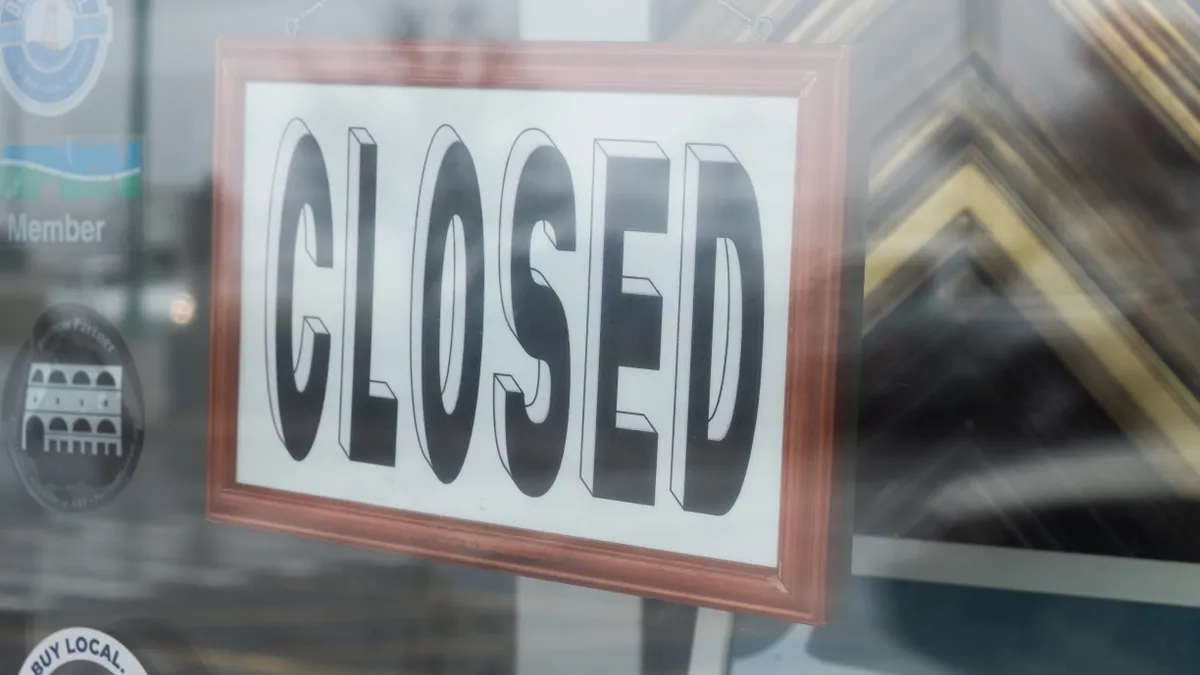Dive Brief:
- Slowing consumer spending, reduced availability of credit and rising penetration of e-commerce may contribute to the closure of 50,000 retail stores by 2027, UBS analysts led by Michael Lasser said in a report published Tuesday. That forecast is based on the assumption that 25% of online orders will be fulfilled by a retail store by 2027, up from 15% now.
- If online penetration reaches 28-29% with 2.5% retail sales growth, up to 130,000 stores could close. Although that estimate is down from what UBS forecasted in 2021, with less access to capital needed to invest in omnichannel, smaller retail chains are most at risk of closing, the analysts said.
- Retailers closed more stores than they opened in 2022, reversing a trend in 2021 that saw about 11,000 net stores added to the U.S. retail sector’s brick-and-mortar footprint. That trend is likely to continue “as a tough macro backdrop and shift in spending away from goods forces closures at smaller, undifferentiated retailers,” the analysts said.
Dive Insight:
Over 5,000 stores across all retail sectors have closed since January 2021 or are set to, according to UBS’s tally. “We believe this trend should continue in the years to come, with consumers consolidating their trips and shifting towards online channels. As underperforming retail stores are shuttered, it should help the store productivity of surviving locations,” the analysts said.
Excluding fuel and food service, the U.S. has a current base of about 940,000 retail stores.
UBS highlighted several factors that are driving retail store closures. They include higher costs, which raise the bar for keeping stores open; a decline in units per store in most retail sectors; and the likelihood that store closures will disproportionately affect smaller chains.
“We suspect the pace of store closures among smaller firms will accelerate going forward as online penetration climbs higher,” the analysts said.
From 2007 to 2019, firms with less than 500 employees closed about 40,000 stores, or 5% of their base, while retailers with more than 500 employees added 17,000 stores. The overall cost of doing business rose significantly in the last 12 months, due in part to higher wages. Retail hourly wages, which are typically the largest cost component of running a store, increased about 5% over the last years, the analysts said.
On top of that, retailers will need to increase store productivity by 4.5% annually as retail rents per square foot increase for neighborhood and community centers. “These costs will likely continue to move higher, increasing the hurdle rate to keep stores open,” UBS said.
About 14,000 of the estimated closings will be in the softlines sector. UBS forecasts that department stores and specialty retailers will remain net store closers. Retailers with a heavy mall presence are likely to continue store closings, but off-price retailers should grow units.
The report also singles out consumer electronics and home furnishings as retail sectors that also need to shrink their store footprint. Consumer electronics retailers should close about 9,000 stores, while home furniture stores should shrink by about 4,000 locations.
One change that’s become essential versus discretionary for retailers is an increasing embrace of digital investments like buy online, pay in store; ship from store; same-day delivery; and buy online, return in store. UBS says online retail spending per household was $9,900 in 2022, up from $8,900 a year ago and up from $4,000 in 2015. Companies with a strong DTC focus combined with high brand loyalty, like Nike and Levi’s, are best positioned for the ongoing shift to digital fulfillment.
And, the report notes, in-store fulfillment of digital orders may reduce the risk of store closures, especially for brands and specialty retailers. That shift to individual stores serving as digital fulfillment centers may also reduce the chance that unprofitable stores will close.















